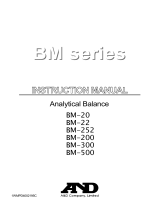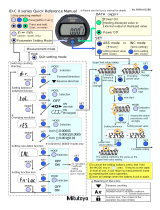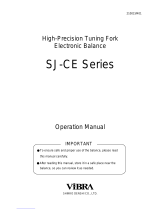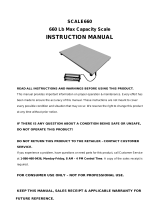Page is loading ...

FZ-i / FX-i SERIES
FZ-120i / FZ-200i / FZ-300i / FZ-500i
F
Z-1200i / FZ-2000i / FZ-3000i / FZ-5000i
F
X-120i / FX-200i / FX-300i / FX-500i
F
X-1200i / FX-2000i / FX-3000i / FX-5000i
Precision Balance
1WMPD4001863C
INSTRUCTION MANUAL

© 2011 A&D Company Ltd. All rights reserved.
No part of this publication may be reproduced, transmitted, transcribed, or translated
into any language in any form by any means without the written permission of A&D
Company Ltd.
The contents of this manual and the specifications of the instrument covered by this
manual are subject to change for improvement without notice.
Windows, Word and Excel are the registered trademarks of the Microsoft Corporation.

1
CONTENTS
Basic Operation
1. INTRODUCTION......................................................................................................................3
1.1. About This Manual ................................................................................................................3
1.2. Features................................................................................................................................3
1.3. Compliance...........................................................................................................................4
2. UNPACKING THE BALANCE ..................................................................................................7
2.1. Unpacking.............................................................................................................................7
2.2. Installing the Balance............................................................................................................8
3. PRECAUTIONS .......................................................................................................................9
3.1. Before Use............................................................................................................................9
3.2. During Use ..........................................................................................................................10
3.3. After Use............................................................................................................................. 11
3.4. Power Supply...................................................................................................................... 11
4. DISPLAY SYMBOLS AND KEY OPERATION ........................................................................12
5. WEIGHING UNITS .................................................................................................................13
5.1. Units....................................................................................................................................13
5.2. Storing Units........................................................................................................................15
6. WEIGHING.............................................................................................................................16
6.1. Basic Operation (Gram Mode) ............................................................................................16
6.2. Counting Mode (PCS).........................................................................................................17
6.3. Percent Mode (%) ...............................................................................................................19
6.4. Statistical Calculation Mode ................................................................................................20
6.5. Statistical Calculation Mode (Example of Use)....................................................................25
Adapting to the Environment
7. RESPONSE ADJUSTMENT...................................................................................................27
8. CALIBRATION........................................................................................................................28
8.1. Calibration Mode.................................................................................................................28
8.2. Calibration Using the Internal mass (One-Touch Calibration, only for FZ-
i series) .............29
8.3. Correcting the Internal Mass Value: 1 (Only for FZ-
i series) ...............................................30
8.4. Correcting the Internal Mass Value: 2 (Only for FZ-
i series) ...............................................31
8.5. Calibration Using an External Weight .................................................................................32
8.6. Calibration Test Using an External Weight ..........................................................................34
9. FUNCTION SWITCH AND INITIALIZATION ..........................................................................36
9.1. Permit or Inhibit...................................................................................................................36
9.2. Initializing the Balance ........................................................................................................37

2
Functions
10. FUNCTION TABLE.................................................................................................................38
10.1. Structure and Sequence of the Function Table ................................................................38
10.2. Display and Keys.............................................................................................................38
10.3. Details of the Function Table ...........................................................................................39
10.4. Description of the Class “Environment, Display”..............................................................42
10.5. Description of the Item “Data Output Mode” ....................................................................44
10.6. Description of the Item “Data Format” .............................................................................45
10.7. Data Format Examples....................................................................................................47
10.8. Description of the Item “Application Function” .................................................................48
10.9. Clock and Calendar Function (Only for FZ-
i series) ........................................................49
10.10. Comparator Function.......................................................................................................51
11. ID NUMBER AND GLP REPORT...........................................................................................52
11.1. Setting the ID Number .....................................................................................................52
11.2. GLP Report......................................................................................................................53
12. UNDERHOOK ........................................................................................................................56
13. PROGRAMMABLE-UNIT .......................................................................................................57
RS-232C Serial Interface
14. RS-232C SERIAL INTERFACE ..............................................................................................58
15. CONNECTION TO Peripheral EQUIPMENT..........................................................................59
15.1. Connection to the AD-8121B Printer................................................................................59
15.2. Connection to a Computer...............................................................................................60
15.3. Using Windows Communication Tools (WinCT) ..............................................................60
15.4. Simultaneously Connecting the AD-8121B Printer and a Personal Computer.................61
16. COMMANDS ..........................................................................................................................62
16.1. Command List .................................................................................................................62
16.2. Acknowledge Code and Error Codes ..............................................................................63
16.3. Settings Related to RS-232C...........................................................................................65
Maintenance
17. MAINTENANCE .....................................................................................................................66
18. TROUBLESHOOTING ...........................................................................................................66
18.1. Checking the Balance Performance and Environment ....................................................66
18.2. Error Codes .....................................................................................................................67
18.3. Asking For Repair............................................................................................................68
19. OPTIONS ...............................................................................................................................69
20. SPECIFICATIONS..................................................................................................................73
21. EXTERNAL DIMENSIONS.....................................................................................................75
22. TERMS/INDEX.......................................................................................................................76

3
1. INTRODUCTION
This manual describes how the FZ-i / FX-i series balance works and how to get the most out of it in
terms of performance.
Read this manual thoroughly before using the balance and keep it at hand for future reference.
1.1. About This Manual
This manual consists of the following five parts:
Basic operation........................ Describes precautions on handling the balance, balance
construction and basic balance operation.
Adapting to the environment .... Describes response adjustment and calibration.
Functions ................................. Describes various functions of the balance.
RS-232C serial interface.......... Describes the interface which transmits data and controls the balance.
Maintenance ............................ Describes maintenance, error codes, troubleshooting,
specifications and options.
1.2. Features
Compact general-purpose balance, can be installed almost anywhere.
The FZ-i series balance is equipped with an internal mass for one-touch calibration.
Casing construction, strong protection against dust and moisture.
Stabilization time of one second. When FAST is selected for the response rate, a stabilization
time of one second, to read a displayed value after a sample is placed on the pan, has been
achieved.
Multiple weighing units with most of the common units used around the world.
Standard RS-232C serial interface to communicate with a computer and to output the Good
Laboratory Practice (GLP) / Good Manufacturing Practice (GMP) compliant report.
Statistical calculation mode to statistically calculate the weight data, and display or output the
sum, maximum, minimum, range (maximum-minimum), average, standard deviation and
coefficient of variation.
Comparator Indicators, displaying the comparison results.
Hold Function, provided for weighing a moving object such as an animal.
Breeze break, provided for the FX-120i/200i/300i/500i, for more accurate weighing.
Underhook, provided for suspended weighing.
As options, the USB interface (FXi-02), the Ethernet interface (Fxi-08) and the built-in battery
unit (Fxi-09) are available.
Connecting the USB interface, by cable to a Windows computer, allows transmission of the weight
data to Excel or Word. The Ethernet interface allows connection of the balance to a personal
computer through a LAN. The battery unit allows use of the balance where a power source is not
available.
The AD-8920A remote display, that is sold separately, allows reading the weight value in a place
away from the balance.

4
1.3. Compliance
Compliance with FCC Rules
Please note that this equipment generates, uses and can radiate radio frequency energy. This
equipment has been tested and has been found to comply with the limits of a Class A computing
device pursuant to Subpart J of Part 15 of FCC rules. These rules are designed to provide
reasonable protection against interference when equipment is operated in a commercial
environment. If this unit is operated in a residential area, it may cause some interference and under
these circumstances the user would be required to take, at his own expense, whatever measures
are necessary to eliminate the interference.
(FCC = Federal Communications Commission in the U.S.A.)
Compliance With Directives of CE mark
This device features radio interference suppression, safety regulation and restriction of Hazardous
Substances in compliance with the following Council Directives
Council directive 2004/108/EC EN61326 EMC directive
Council directive 2006/95/EC EN60950 Safety of Information Technology Equipment
Council directive 2011/65/EU EN50581 Restriction of the use of certain Hazardous Substances
The CE mark is an official mandatory European marking.
Please note that any electronic product must comply with local laws and regulations when sold or
used anywhere outside Europe.

5

6

7
AC adapter
AC adapter
ID label
RS-232C
serial interface
Main unit rear side
AC adapter jack
Grounding
terminal
AC adapter plug
Keys
Weighing pan
Main unit
Display
Bubble spirit
level
Leveling foot
Pan support
Main unit cove
r
How to assemble the breeze break
(For
the
FZ-
i
series (all) and
FX-120
i
/200
i
/300
i
/500
i
)
Assemble the breeze break as shown below.
Follow the numbered sequence.
4
1
2
3
2. UNPACKING THE BALANCE
2.1. Unpacking
The balance is a precision instrument. Unpack the balance carefully. Keep the packing material
to be used for transporting the balance in the future.
The packing contents depend on the balance model. See the illustrations to confirm that
everything is contained.
Note
Please confirm that the AC adapter type is correct
for your local voltage and receptacle type.
The AC adapter plug is
protected against dust
and may be difficult to
insert. When inserting
the plug, turn the plug
while pushing on it.
A
luminum pan support
for FZ-5000i and FX-5000
i

8
2.2. Installing the Balance
Install the balance as follows:
1. Place the balance on a solid weighing table. Refer to “3. PRECAUTIONS” for installing the balance.
2. The FZ-i series (all) and FX-120i /200i /300i /500i
Assemble the pan support, weighing pan and breeze break, on the balance as shown in the
illustration on page 7.
FX-1200i /2000i /3000i /5000i
Assemble the pan support and weighing pan on the balance as shown in the illustration on page 7.
3. Adjust the leveling feet to level the balance. Confirm it using the bubble spirit level.
4. Confirm that the AC adapter type is correct for the local voltage and power receptacle type.
5. Connect the AC adapter to the balance. Warm up the balance for at least 30 minutes with
nothing on the weighing pan.
Note
The AC adapter plug is protected against dust and may be difficult to insert. When inserting
the plug, turn the plug while pushing on it.

9
3. PRECAUTIONS
To get the optimum performance from the balance and acquire accurate weight data, note the following:
3.1. Before Use
Install the balance in an environment where the temperature and humidity are not excessive.
The best operating temperature is about 20°C / 68°F at about 50% relative humidity.
Install the balance where it is not exposed to direct sunlight and it is not affected by heaters or air
conditioners.
Install the balance where it is free of dust.
Install the balance away from equipment which produces magnetic fields.
Install the balance in a stable place avoiding vibration and shock. Corners of rooms on the first
floor are best, as they are less prone to vibration.
The weighing table should be solid and free from vibration, drafts and as level as possible.
Level the balance by adjusting the leveling feet and confirm it using the bubble spirit level.
Make sure that the bubble is in the center of the red circle.
Ensure a stable power source when using the AC adapter.
Plug in the AC adapter and warm up the balance for at least one hour.
Calibrate the balance before use or after having moved it to another location.
Caution: Do not install the balance where flammable or corrosive gas is present.

10
3.2. During Use
Discharge static electricity from the material to be
weighed (hereinafter referred to as the sample). When a
sample could have a static charge, the weight data is
influenced. Ground the balance and try the following:
Eliminate static electricity using the optional AD-1683
DC static eliminator.
Try to keep the ambient humidity above 45%RH.
Use a metal shield case for a charged sample.
Wipe charged plastic samples with a moistened cloth.
This balance uses a strong magnet as part of the
balance assembly, so please use caution when
weighing magnetic materials such as iron. If there is a
problem, use the underhook on the bottom of the
balance to suspend the material away from the
influence of the magnet.
Eliminate the temperature difference between a sample
and the environment. When a sample is warmer (cooler)
than the ambient temperature, the sample will be lighter
(heavier) than the true weight. This error is due to a
rising (falling) draft around the sample.
Make each weighing gently and quickly to avoid errors caused by the evaporation of moisture
from the sample or the absorption of moisture by the sample.
Do not drop things upon the weighing pan, or place a sample on the pan that is beyond the
balance weighing capacity. Place a sample in the center of the weighing pan.
Do not use a sharp instrument such as a pencil to press the keys. Use your finger only.
Press the RE-ZERO key before each weighing to eliminate possible errors.
Calibrate the balance periodically so as to eliminate possible errors.
Take into consideration the affect of air buoyancy on a sample when more accuracy is required.
Keep the balance interior free of dust and foreign materials.
The breeze break (The FZ-i series (all) and FX-120i /200i /300i /500i (only)) is provided as a
standard accessory. An anti-static treatment has been applied to the breeze break components,
but they may be charged with static electricity when they are unpacked or when the humidity is
low. If the weight value is unstable even when there are no drafts or the balance has a problem
with repeatability, remove the breeze break. Or wipe the clear plates with a moistened cloth, use
the optional AD-1683 DC static eliminator or apply an anti-static spray.

11
3.3. After Use
Avoid mechanical shock to the balance.
Do not disassemble the balance. Contact the local A&D dealer if the balance needs service or
repair.
Do not use organic solvents to clean the balance. Clean the balance with a lint free cloth that is
moistened with warm water and a mild detergent.
The edge of the weighing pan is sharp. Use much care when cleaning the pan.
Avoid dust and water so that the balance weighs correctly. Protect the internal parts from liquid
spills and excessive dust.
3.4. Power Supply
When the AC adapter is connected, the balance is in the standby mode if the standby indicator
is on (refer to “4. DISPLAY SYMBOLS AND KEY OPERATION”). This is a normal state and
does not harm the balance. For accurate weighing, warm up the balance for at least 30 minutes
before use.

12
4. DISPLAY SYMBOLS AND KEY OPERATION
Key operation
Key operation affects how the balance functions. The basic key operations are:
“Press and release the key immediately” or “Press the key”
= normal key operation during measurement
“Press and hold the key”
Display symbols
Each key, when pressed or when pressed and held, functions as follows:
Key When pressed When pressed and held
Turns the display on or off. The standby indicator is displayed when the display is turned
off. The weighing mode is enabled when the display is turned on.
This key is available anytime. Pressing the key during operation will interrupt the operation
and turn the display off.
In the weighing mode, turns the minimum
weighing value on or off.
In the counting or percent mode, enters
the sample storing mode.
Enters the function table mode.
Refer to “10. FUNCTION TABLE”.
Switches the weighing units stored in the
function table.
Refer to “5. WEIGHING UNITS”.
Enters the response adjustment mode.
Cancels the operation when performing
settings. With the FZ-i series, enters the
calibration mode using the internal mass.
(One-touch calibration)
Enters the calibration mode.
Outputs the weight data to a printer or
personal computer using the RS-232C
serial interface, depending on the function
table settings.
Confirms the operation when performing
settings.
No function at the factory setting
By changing the function table:
Outputs “Title block” and “End block” for
GLP/GMP compliant report.(Refer to "11-2
GLP Report".)
Sets the display to zero.

13
5. WEIGHING UNITS
5.1. Units
With the FZ-i / FX-i series balance, the following weighing units and weighing modes are available:
A unit or mode can be selected and stored in the function table as described below.
If a weighing mode (or unit of weight) has been turned off, that mode or unit will be missing in the
sequence. Tael has four varieties, one of which can be selected and installed at the factory.
To select a unit or mode for weighing, press the MODE key.
For details about the units and modes, see the table below:
Name (unit, mode) Abbrev. Display Function table
(Storing mode)
Conversion factor
1 g =
Gram g g g 1 g
Counting mode Pcs pcs pcs
Percent mode % % %
Ounce (Avoir) Oz oz oz 28.349523125 g
Pound Lb lb lb 453.59237 g
Pound/Ounce
L
OZ
Loz
LO
1Lb=16 oz,
1 oz=28.349523125 g
Troy Ounce Ozt ozt ozt 31.1034768 g
Metric Carat Ct ct ct 0.2 g
Momme Mom 3.75 g
Pennyweight Dwt dwt dwt 1.55517384 g
Grain (UK) GN GN GN 0.06479891 g
Tael (HK general, Singapore) 37.7994 g
Tael (HK jewelry) 37.429 g
Tael (Taiwan) 37.5 g
Tael (China)
TL
tl tl
31.25 g
Tola (India) Tol tol tol 11.6638038 g
Messghal Mes 4.6875 g
Programmable-unit (Multi-unit) Mlt MLT MLT
Percent mode
Programmable-unit (No unit displayed. For details, refer to "12. PROGRAMMABLE-UNIT".)
Counting mode
%
oz
ozt
ct
dwt
GN
tl tol
MLT
g
pcs
lb
es
oz

14
The tables below indicate the weighing capacity and the minimum display for each unit, depending on
the balance model.
Capacity
Unit
FZ-120i
FX-120i
FZ-200i
FX-200i
FZ-300i
FX-300i
FZ-500i
FX-500i
Minimum
display
Gram 122 220 320 520 0.001
Ounce (Avoir) 4.30 7.76 11.2 18.3 0.00005
Pound 0.268 0.485 0.70 1.14 0.000005
Pound/Ounce 0L 4.30 oz 0L 7.76 oz 0L 11.29 oz 0L 18.34 oz 1L 0.01 oz
Troy Ounce 3.92 7.07 10.2 16.7 0.00005
Metric Carat 610 1100 1600 2600 0.005
Momme 32.5 58.6 85.3 138 0.0005
Pennyweight 78.4 141 205 334 0.001
Grain (UK) 1882 3395 4938 8024 0.02
Tael (HK general, Singapore) 3.22 5.82 8.46 13.7 0.00005
Tael (HK jewelry) 3.25 5.87 8.54 13.8 0.00005
Tael (Taiwan) 3.25 5.86 8.53 13.8 0.00005
Tael (China) 3.90 7.04 10.2 16.6 0.00005
Tola (India) 10.4 18.8 27.4 44.5 0.0001
Messghal 26.0 46.9 68.2 110 0.0005
Capacity
Unit
FZ-1200i
FX-1200i
FZ-2000i
FX-2000i
FZ-3000i
FX-3000i
FZ-5000i
FX-5000i
Minimum
display
Gram 1220 2200 3200 5200 0.01
Ounce (Avoir) 43.0 77.6 112 183 0.0005
Pound 2.68 4.85 7.05 11.4 0.00005
Pound/Ounce 2L 11.03 oz 4L 13.60 oz 7L 0.88 oz 11L 7.42 oz 1L 0.01 oz
Troy Ounce 39.2 70.7 102 167 0.0005
Metric Carat 6100 11000 16000 26000 0.05
Momme 325 586 853 1386 0.005
Pennyweight 784 1414 2057 3343 0.01
Grain (UK) 18827 33951 49383 80248 0.2
Tael (HK general, Singapore) 32.2 58.2 84.6 121 0.0005
Tael (HK jewelry) 32.5 58.7 85.4 137 0.0005
Tael (Taiwan) 32.5 58.6 85.3 138 0.0005
Tael (China) 39.0 70.4 102 166 0.0005
Tola (India) 104 188 274 445 0.001
Messghal 260 469 682 1109 0.005

15
5.2. Storing Units
The units or modes can be selected and stored in the function table. The sequence of displaying the
units or modes can be arranged in the function table so as to fit the frequency of use.
Select a unit or mode and arrange the sequence of display as
follows:
1 Press and hold the SAMPLE key until ba5fnc of the
function table is displayed.
2 Press the SAMPLE key several times to display
1Unit .
3 Press the PRINT key to enter the unit selection mode.
4 Specify a unit or mode in the order to be displayed using
the following keys.
SAMPLE key To sequentially display the units.
RE-ZERO key To specify a unit or mode. The
stabilization indicator appears
when the displayed unit or mode is
specified.
5 Press the PRINT key to store the units or modes. The
balance displays end and then displays the next menu
item of the function table.
6 Press the CAL key to exit the function table. Then the
balance returns to the weighing mode with the unit
specified first in step 4.
Notes
When the power is turned on, the scale displays the unit
specified first in step 4.
In the weighing mode, to select a unit or mode for weighing,
press the MODE key.
Select
Specify
Store
Displays the units
sequentially.

16
6. WEIGHING
6.1. Basic Operation (Gram Mode)
1 Place a container on the weighing pan, if necessary.
Press the RE-ZERO key to cancel the weight (tare). The
balance displays 0.00 g. (The decimal point position
depends on the balance model.)
2 Place a sample on the pan or in the container.
3 Wait for the stabilization indicator to turn on. Read the
value.
While the stabilization indicator is on, pressing the PRINT
key will output the weight value, using the RS-232C serial
interface.
Note
Peripheral equipment, that is sold separately , such as a
printer or a personal computer is required.
4 Remove the sample and container from the pan.
Notes
To use other units, press the MODE key and select an
appropriate unit.
Press the SAMPLE key to turn on or off the minimum
weighing value.
When the ON:OFF key is pressed with a container placed on
the weighing pan, the balance displays 0.00 g and weighing is
started,

17
6.2. Counting Mode (PCS)
This is the mode to determine the number of objects in a sample based on the standard sample unit
mass. The unit mass means the mass of one piece of the sample. The smaller the variables in each
sample unit mass are, the more accurate the counting will be. The balance is equipped with the
Automatic Counting Accuracy Improvement (ACAI) function to improve the counting accuracy.
Notes
For counting, use samples with a unit mass of at least ten or more times the minimum
weighing value of the balance,.
If the sample unit mass variable is too large, it may cause a counting error.
To improve the counting performance, use the ACAI function frequently or divide the samples
into several groups and count each group.
Selecting the counting mode
1 Press the MODE key to select 1pcs (counting mode).
Storing a sample unit mass
2 Press the SAMPLE key to enter the sample unit mass
storing mode.
Even in the storing mode, pressing the MODE key will
switch to the next mode.
3 To select the number of samples, press the SAMPLE key
several times. It may be set to 5, 10, 25, 50 or 100.
Note
A greater number of samples will yield more accurate
counting result.
4 Place a container on the weighing pan, if necessary. Press
the RE-ZERO key to cancel the weight (tare). The number
specified in step 3 appears.
e.g.: 25 0 is displayed if 25 is selected in step 3.
5 Place the number of samples specified on the pan. In this
example, 25 pieces.
6 Wait for the stabilization indicator to turn on. Press the
PRINT key to calculate and store the unit mass. The
balance displays 25
pcs
(counting mode) and is set to
count samples with this unit mass.
To improve the accuracy of the unit mass, go to step 8.

18
Notes
If the balance judges that the mass of the samples is too light and is not adequate to be used as
the unit mass, it displays lo . In that case, store the mass by some quantity. For example, when
the model with the minimum weighing value of 0.01 g is used and 10 pieces of samples weigh
0.05 g. Store 100 pieces of samples as 10 and multiply the weighing result by 10.
If the balance judges that the mass of the samples is too light to acquire accurate weighing, it
displays an error requiring the addition of more samples to the specified number. For example,
150-
PCS
appears to require 25 more samples. Add 25 samples and press the PRINT key.
When the unit mass is stored correctly, the balance proceeds to the counting mode.
For a more accurate counting operation, use samples with a unit mass of at least ten or more
times the minimum weighing value of the balance. For example, when a balance with a
minimum weighing value of 0.01 g is used, the recommended sample unit mass is 0.1 g or
more.
The sample unit mass stored, even if the AC adapter is removed, is maintained in non-volatile
memory.
Counting operation
7 Place the samples to be counted on the pan.
While the stabilization indicator is on, pressing the PRINT
key will output the weight value (number of objects), using
the RS-232C serial interface.
Note
Peripheral equipment, that is sold separately , such as a
printer or a personal computer is required.
Counting mode using the ACAI function
The ACAI is a function that improves the accuracy of the unit
mass automatically by increasing the number of samples and
averaging the unit mass variable to minimize the weighing
error, as the counting process proceeds.
8 If a few more samples are added, the processing indicator turns on. To prevent an error, add
three or more. The processing indicator does not turn on if overloaded. Try to add the same
number of samples as displayed.
9 The balance re-calculates the unit mass while the processing indicator is blinking. Do not touch
the balance or samples on the pan until the processing indicator turns off.
10 Counting accuracy is improved when the processing indicator turns off.
Each time the above operation is performed, a more accurate unit mass will be obtained. There
is no definite upper limit of ACAI range for the number of samples exceeding 100. Try to add
the same number of samples as displayed.
11 Remove all the samples used in ACAI and proceed with the counting operation using the
improved unit mass.
/











